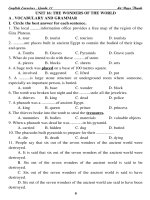Unit 16: B. Speaking
Bạn đang xem bản rút gọn của tài liệu. Xem và tải ngay bản đầy đủ của tài liệu tại đây (688.91 KB, 7 trang )
Unit 16: HISTORICAL
Unit 16: HISTORICAL
PLACES
PLACES
Period 97
Period 97
:
:
Unit 16: HISTORICAL PLACES
Unit 16: HISTORICAL PLACES
Task 1. A foreign visitor has been taken some notes about President Ho Chi Minh’s
Mausoleum. Ask and answer questions with a partner, using his notes.
Example: A: Where is President Ho Chi Minh’s Mausoleum situated?
B: It is situated in Ba Dinh Distric in Hanoi.
A: When did the construction of the Mausoleum start?
B: I started in September 1973.
B. SPEAKING
PRESIDENT HO CHI MINH’S MAUSOLEUM
Place: Ba Dinh Distric, Hanoi.
Built in September 1973, completed in August
1975
1
st
floor: a stand for important meetings
organised at Ba Dinh Square,
2
nd
floor: where the late president is lying, 3
rd
foor: the roof
Visiting hours: 7:30 – 20:30 a.m. in summer
and 8:00 – 11;00 a.m. in winter. Every day excepr
Monday and Friday.
Usually closed September 5 – December 10
for maintenance.
No photography allowed inside.
Period 97
Period 97
:
:
Unit 16: HISTORICAL PLACES
Unit 16: HISTORICAL PLACES
B. SPEAKING
Suggests:
Suggests:
A: When did the construction of the Mausoleum start?
B: It started in September 1973.
A: When did it finished?
B: It finished in August 1975.
A: How many floors are there in the Mausoleum?
B: There are 3 floors.
A: What is the use of each floor?
B: The first floor is a stand for important meetings organised at Ba Dinh Square;
the second floor is the place where the late president is lying and the tird foolr is
the roof.
A: On what day can we visit the Mausoleum?
B: We can visit it on Tuesday, Wednesday, Thursday, Saturday and Sunday.
Etc …
Period 97
Period 97
:
:
Unit 16: HISTORICAL PLACES
Unit 16: HISTORICAL PLACES
B. SPEAKING
Task 2. Work in pairs. Take turns to act as a tourist guide and give a short
introduction to either of the historical places below, suing the information given.
Hue imperial City
Listed as a World Cultural Heritage by UNESCO in 1993
In Hue City, 654 km from Hanoi and 1071 km from Ho Chi Minh City
Construction: started 1805 and completed 1832
Comprises 3 sections: the Royal Citadel, the Imperial Enclosure and
the Forbidden City
Open daily from 8:00 a.m to 4:30 p.m.
Admission free: 55,000 VND.
Thong Nhat Conference Hall
Also called Reunification Hall or Independence Palace
In Distric No1, Ho Chi Minh City, 1730 km south of Hanoi
Originally built in 1865 and heavily damaged by an air
bombardment in February 1963
Rebuilt and construction completed in 1966
Has 5 floors with 100 beautifully decorated rooms and chambers.
Open daily from 7:30 to 11:00 a.m and from 1:00 to 4:00 p.m.
Admission free: 10000VND
Period 97
Period 97
:
:
Unit 16: HISTORICAL PLACES
Unit 16: HISTORICAL PLACES
B. SPEAKING
Suggests:
Hue, the former imperial capital of Vietnam, is on the romantic
Huong River, not far from the Truong Son Range. It’s in the central
Vietnam, 654 km from Hanoi and 1071 km from Ho Chi Minh City.
It was built in 1832, and considered as a World Cultural Heritage by
UNESCO in 1993. Hue and comprises 3 sections: the Royal Citadel,
the Imperial Enclosure and the Forbidden Purplr City. If you have a
chance to travel to Hue, come to visit it and you will see how
beautiful it is. In fact, Hue is a very beautiful and poetic city with
trees on both sides of many streets and large pavements for people
to walk. Coming to Hue, you should spend a little time visiting the
imperial palace of the Nguyen Dynasty, temples, pagodas, and royal
tombs. Hue is also famous for the Huong River, Mount Ngu Binh
and its old garden houses, where you can see shady trees, bonsai,
orchild flowers, and so on.









